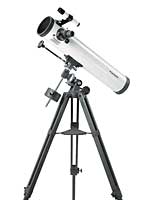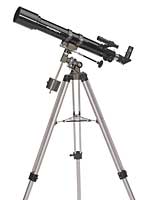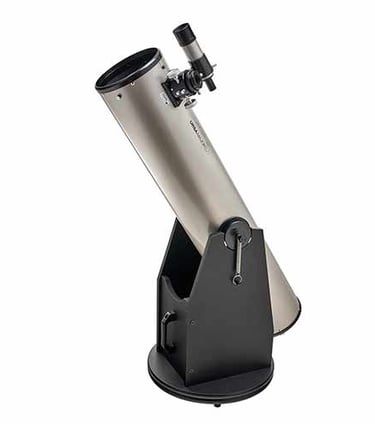Buying a Telescope
Reflector?, refractor?, 60mm?, 4.5inch?, £150?, £299? questions, questions.....If you are thinking of buying a telescope but don't know what to buy, where to buy it or how much to pay, then read on. This guide will hopefully make the choice a bit clearer.
The best telescope you can buy is the one you will use the most. Some telescopes are light to carry, easy to set up and you can be using them in a few minutes. Other scopes can be heavy, need collimation or calibration and this means they can take a while to set up. For a beginner's telescope I would definitely recommend going for the easy to set up option.
My first telescope was a Russian made 4.5 inch reflector and of all the scopes I have owned that was probably the one I used the most.
Reflector or Refractor?
For your first scope you are probably looking at either a reflector or a refractor.
REFLECTOR


A reflector uses a large primary mirror and a smaller secondary mirror to bounce the incoming light through to a lens. It has the advantage of being relatively cheap to produce (and therefore buy). This means your budget will stretch to a telescope with a wider aperture when buying a reflector.
A reflector will be better at picking out dimmer objects such as distant galaxies or nebulae. A 4.5 inch reflector is a decent size starter scope.
Larger reflector scopes sometimes come with a rotating base rather than a tripod. These scopes are known as Dobsonians.
When most people think of a telescope they think of a refractor. Unlike the reflector which is open at one end, the refractor is a sealed tube. It has an objective lens at one end that concentrates the light into the eyepiece at the other end. This design normally gives a slightly better image of the planets and the moon.
They tend to be lightweight and portable, easy to set up and intuitive to use, give sharp views and require practically no maintenance.
The refractor tends to have a smaller aperture than reflectors which means they let in less light so are not as good at observing dimmer objects. Refractors are quite expensive to make and large scopes with bigger apertures can become quite costly to buy.
A 60 - 90mm refractor is a good starter scope.
REFRACTOR




If you are looking for the biggest aperture telescope you can buy then a Dobsonian offers the most bang for your bucks. They are often referred to as light buckets for the amount of light they collect.
Would I recommend a Dobo as a first scope? Probably not. They can be quite heavy, are not very portable and can take up a lot of storage space when not in use. They also need collimation to make sure the mirrors don't go out of alignment. Brilliant scopes but probably not for a beginner.
WHERE TO BUY?
I would recommend going to a specialist telescope retailer. There are plenty on line and they will be able to guide you to a scope suitable to you and help with any questions you have. Definitely avoid any toy shops or general retailers who offer a very cheap starter scope. With telescopes you pretty much get what you pay for. Buying a cheap scope from a toy shop will probably just lead to a very disappointing experience when you try to use it.
Also, I would avoid telescopes where the box boasts of 500x magnification. Technically it might be possible but to see anything meaningful at that magnification requires superb quality optics and cheaper scopes will not work at all well at high magnification. In fact, when buying a telescope don't get hung up on magnification. Lower magnifications give clearer and crisper images and you can see an awful lot at say, 32x magnification.
EXPECTATIONS
It's a pretty useful to have some idea what to expect from a small telescope. It's easy to look at the spectacular photos in astronomy books and let your expectations soar. Some people do expect a bit too much out of a small scope. Most of the photos in books are taken with extremely large telescopes in the middle of Australia or Mexico. They are often multi exposure photos taken with different filters that bring out all the colours in the subject. This isn't what you will see from your backgarden with a £200 scope.
Having said that a good small telescope can capture a lot of beautiful and wonderful celestial sights. You will be able to view the moon and go crater hopping, see Jupiter with its largest four moons strung out alongside it, Saturn and it's unmistakable rings, the ever changing crescent of Venus and the fiery red of Mars. You will be able to see nebula, star clusters and the Great Andromeda galaxy that lies about 2.5m light years beyond our own galaxy, the Milky Way. Pretty amazing stuff!
TIPS ON USING A TELESCOPE
Once you've bought your first scope there are a few things to bear in mind.
Spend a bit of time reading the instructions and if necessary balancing the telescope. It will avoid frustration.
Some telescopes come with solar filters so that you can view the sun. Leave them in the box. They do not always cut out all the harmful ultra violet rays from the sun. Never look through a telescope at the sun, with or especially without a filter. You've only got one set of eyes. Keep them.
A telescope is an outdoor instrument. If you only use it inside the house pointing it out of a window you will never get steady images because of the thermals created by the house. Get it outside, preferably on a nice patch of grass.
When you take a telescope outside on a cold night, allow it to cool down for twenty minutes or so. After this time you will get clearer images.
Let your eyes adapt to the darkness. Once you have let them grow accustomed to the dark, you will be able to see more through the telescope.
When looking through the telescope at a very dim object, try looking around it instead of directly at it. By using averted vision you may be able to see it clearer.
Happy Viewing